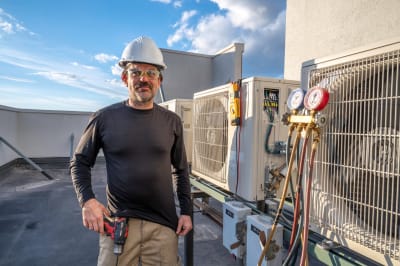Electricians are professionals with extensive knowledge of electric and wiring systems. Apart from already being one of the most popular and easily recognizable professions on the planet, the demand for electricians continues to rise.
And although many aspire to pursue a career in the field, only a few have the required knowledge. You’ve come to the right place if you find yourself in these shoes.
In the guide below, you’ll find everything you need to know about the electrician field, including what electricians do, where they work, their potential salary and career outlook, and how to become one.
What Do Electricians Do?
Electricians offer services related to installing, maintaining, fixing, and upgrading electrical systems. Specific tasks often include the installation of wiring in a new building, troubleshooting problems with existing systems, and using hand and power tools to fix broken components, among others. An electrician is also capable of running risk management operations to ensure that the system is functional and safe.
Naturally, an electrician must be good with tools and be physically sound, seeing as the job does have intense demands on the body.
Electricians Work Environment
About two-thirds of electricians work for electrical contractors as part of a team. Those who only work for themselves often have their own electrical companies.
Regarding specific work environments, electricians are often grouped into two categories - residential electricians and commercial electricians. While the former specializes in residential buildings and components, the latter is more suited for commercial and industrial installations and components.
As mentioned earlier, the job of an electrician can be really demanding. You’ll often find electricians standing for a prolonged time, squatting, climbing structures, and crawling in vents and enclosed spaces.
How To Become an Electrician
Electricians often follow one of two pathways - formal education through a vocational school or apprenticeship. It can even be both sometimes. Below is an outline of a more comprehensive path to becoming an electrician:
High School Diploma or GED
College degrees are not part of the mandatory requirements for becoming an electrician, but high school diplomas are. This is because no matter which path you choose afterward, be it a vocational school or an apprenticeship, the institution will require a high school diploma or GED.
Also, high school courses such as math and science, construction, physics, trigonometry, and even English are essential to imbibe aspiring electricians with some of the knowledge and skills they’ll require throughout their careers.
Trade School
After high school, the following path often is a trade school. This is different from saying everyone goes through this route, but those looking for a more formal education do. Electrician programs at trade schools and community colleges can be completed in as little as a year.
However, those who opt for an associate’s degree will have to be prepared to spend a minimum of two years. Trade school programs often incorporate an element of practical lab work along with theoretical classroom lectures for a complete experience.
Apprenticeship
While some choose to go through formal education, some opt for apprenticeship programs. Both paths have benefits, and there is no need for a consensus on the best.
Many electricians undergo apprenticeship programs after completing community college/trade school programs. One benefit of this is that they get all the theoretical knowledge possible from a school while getting the opportunity to work side by side with seasoned professionals in a trade school.
Apprenticeship programs are often available through independent electric contractors, electrical unions, and the Joint Apprentice Training Committee.
Start Your Career
At this point, it is possible to start practicing as an electrician, even without certification. One of the perks of completing an apprenticeship program is that you may get lucky and be hired by the same company where you took the apprenticeship.
Usually, though, you will need to get certified to secure employment elsewhere.
Certification & Licenses
An electrician has a few options regarding which certifications to go for. Some of the most popular include Journeyman Electrician, Master Electrician, Residential Electrician, and Commercial Electrician.
Each of these has its requirements in terms of the experience needed and the nature of the exams. The Journeyman Electrician certification, for example, requires completion of an apprenticeship program and knowledge of electrical theory, system, and circuit grounding, among others.
Electrician Specializations
Electricians specialize in four specialty areas - outside linemen, inside wiremen, installer technicians, and residential wiremen. As the name suggests, outside linemen work outside on electrical power lines while an inside wireman works on-premises, connecting electrical equipment to the primary power source.
Installer technicians work alongside the inside wireman to install new outlets. In contrast, a residential wireman performs a similar function to the inside wireman, connecting residential equipment to a primary source. Still, they also have the duty of maintaining electrical systems in homes.
Average Electrician Salary
According to the Bureau of Labor Statistics, electricians earn a median salary of $60,040. Those who fall into the lower 10% may earn as high as $37,020, while those who fall into the top 10 percent can expect to earn about $99,800.
The industry wherein an electrician belongs can also greatly influence how much they earn. Data shows that electricians in government institutions earn the most, with a median salary of $63,640, while manufacturing workers earn $62,210. Electrical contractors earn $58,760.
Electrician Job & Career Outlook
The outlook for the field is quite promising, according to the BLS. The Bureau projects a 7 percent increase in electrician demand in the next ten years. This will see 79,900 new electrician jobs created every year.
Many of these will arise from the need to replace workers who retire or move on to a new profession. Another cause will be the need to maintain, install and replace electrical systems as new houses are built.





